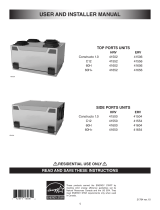
7
For the User
4. WARRANTY
This unit is a high-quality product, built and packaged with care. The manufacturer warrants to the original purchaser of its product, that
such products will be free from defects for the period stated below, from the date of original purchase. For all units, the warranty covers
parts only against any operational defect. This is a 5-year warranty. Subject to performing the core maintenance according to user guide
recommendations, the energy recovery core (ERV) has a 5-year warranty, except for S10d ERV ECM, S10d ERV ECM-R, 70Ed ECM and
70Ed ECM-R; their energy recovery core has a 2-year warranty.
If any defect should occur, we urge you to read the user guide carefully. If
the problem persists, observe the following rules:
RULES TO FOLLOW
If the unit is defective, contact your ventilation contractor (see address on your user manual cover page). The contractor will determine
with you the reason for the defect, and if needed, do the replacement or repair. If ever it is impossible to reach your ventilation contractor,
call 1-800-567-3855 (in North America); the personnel will be pleased to give you the phone number of a distributor or a service center
near you.
REPLACEMENT PARTS AND REPAIR
In order to ensure your ventilation unit remains in good working condition, you must use the manufacturer's genuine replacement parts only.
The manufacturer's genuine replacement parts are specially designed for each unit and are manufactured to comply with all the applicable
certification standards and maintain a high standard of safety. Any third party replacement part used may cause serious damage and
drastically reduce the performance level of your unit, which will result in premature failing. The manufacturer also recommends contacting
a service depot certified by the manufacturer for all replacement parts and repair.
BILL OF PURCHASE
No replacement or repair covered by the warranty will be carried out unless the unit is accompanied by a copy of the original bill of
purchase. Please retain your original.
MISCELLANEOUS COSTS
In each case, the labor costs for the removal of a defective part and/or installation of a compliant part will not be covered by the manufacturer.
CONDITIONS AND LIMITATIONS
These units are created for residential use only and must be used in a building as defined below:
Building: All structures zoned and/or erected for the act, process or art of human or animal habitation and/or the storage or
warehousing of goods.
Residential use: Dwelling, lodging, suite: Building, or part of a building, intended to act as either the domicile to one or several people
which can include general sanitary, food consumption and rest facilities. Buildings of only one room or a group of
rooms including those occupied by a tenant or owner; comprise the lodgings, the individual rooms of the motels,
hotels, rooming/lodging houses, boarding/half-way/foster homes, dormitories, and suites, as well as the stores and the
business establishments constituted by only one room in a dwelling.
Commercial use: Agricultural establishment, commercial establishment for assembly, care, or detention: Building or part of a building that
does not contain a dwelling, situated on land dedicated to agriculture or farming and used primarily to shelter animals,
or for the production, the storage or the treatment of agricultural or horticultural products or animal food. Building or part
of a building, used for the display or retail of goods, professional or personal services, or commodities. Building, or part
of a building used by persons gathering for civic activities, religious or political assembly, tourism, educational/vocational
training, recreation or the consumption of food or drink. Building, or part of a building used to shelter persons of impaired
physical or psychological states, persons requiring palliative care or medical treatments, or persons for reasons out of
their control, cannot escape harm or threat of danger autonomously.
Industrial use: Building, or part of a building, used for the assembly, the manufacture, the creation, the treatment, the repair or the
storage of products and combustible materials and that contain fuels that when ignited or exploded in sufficient quantity
may constitute a risk of fire.
The above warranty applies to all cases where the damage is not a result of poor installation, improper use, mistreatment or negligence, acts
of God, or any other circumstances beyond the control of the manufacturer. Furthermore, the manufacturer will not be held responsible for
any bodily injury or damage to personal property or real estate, whether caused directly or indirectly by the unit.This warranty supersedes
all prior warranties.




























